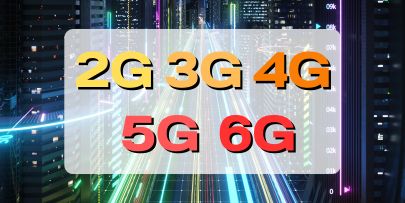The Latency of the different Mobile Networks.
Considering latency pf the Mobile Networks is vital for your MVNO’s success. Lower latency enhances user experience, leading to higher customer satisfaction, retention, and positive reviews. It also provides a competitive edge, especially in markets where real-time applications are prevalent. Additionally, low latency ensures your MVNO is well-prepared for future technologies and customer demands, making it a strategic consideration when selecting network technologies for your MVNO.
What is the Latency of the different Mobile Networks?
- Why does the Latency of the Mobile Network matter for Your MVNO?
- What is the Latency of the different Mobile Networks?
- What is the Latency of the 2G (Second Generation) Mobile Network?
- What is the Latency of the 3G (Third Generation) Mobile Network?
- What is the Latency of the 4G (Fourth Generation) Mobile Network?
- What is the Latency of the 5G (Fifth Generation) Mobile Network?
- What is the Latency of the 6G (Sixth Generation) Mobile Network?
- Summary of is the Latency of Mobile Networks
Why does the Latency of the Mobile Network matter for Your MVNO?
Real-time Applications
Applications like online gaming, video conferencing, and live streaming require low latency to provide seamless and responsive experiences. Customers expect these services to be instantaneous, making low latency essential for user satisfaction.
IoT and Automation
For IoT devices, especially those used in industrial automation, low latency is vital. Quick data transmission ensures timely responses to critical events and efficient automation processes.
Emerging Technologies
Low latency is essential for emerging technologies such as augmented reality (AR), virtual reality (VR), and mixed reality (MR). These technologies rely on real-time interactions, requiring networks with minimal delay.
Competitive Edge
Offering low-latency services can give your MVNO a competitive advantage. Users are more likely to stay with your service if they have a smooth experience, which low latency ensures.
Future Proof
Considering the latency capabilities of different networks is essential for future-proofing your MVNO. As technology advances, applications requiring lower latency will become more prevalent, making 4G and 5G networks more attractive options.
What is the Latency of the different Mobile Network?
Below is a breakdown of the latency of 2G, 3G, 4G, 5G and 6G networks, and why they matter for your MVNO.
1. What is the Latency of the 2G (Second Generation) Mobile Network?
2. What is the Latency of the 3G (Third Generation) Mobile Network?
3. What is the Latency of the 4G (Fourth Generation) Mobile Network?
4. What is the Latency of the 5G (Fifth Generation) Mobile Network?
5. What is the Latency of the 6G (Sixth Generation) Mobile Network?

What is the Latency of the 2G (Second Generation) Mobile Network?

Expected Latency
2G networks typically exhibit latency ranging from 300ms to 1000ms.
Significance for Your MVNO
In 2G networks, data packets experience relatively high latency due to the older technology and slower data transfer rates. This delay can lead to noticeable lags in communication. For instance, when making voice calls or sending text messages, users might not perceive the latency. However, it becomes apparent when using applications that require real-time interactions, such as online gaming or video conferencing. High latency can result in delays in receiving and processing information, impacting the user experience negatively.
What is the Latency of the 3G (Third Generation) Mobile Network?

Expected Latency
3G networks generally have latency ranging from 100ms to 300ms.
Significance for Your MVNO
3G networks provide lower latency compared to 2G, enabling quicker data transmission. While 3G technology offers improvements over 2G, it may still exhibit noticeable delays for real-time applications. The latency is reduced, making services like video calls smoother. However, it might not be ideal for highly interactive applications where faster response times are critical.
What is the Latency of the 4G (Fourth Generation) Mobile Network?

Expected Latency
4G networks typically have latency ranging from 20ms to 50ms.
Significance for Your MVNO
4G technology represents a significant leap forward in terms of latency reduction. The low latency of 4G networks makes them ideal for various real-time applications. Online gaming, high-definition video streaming, and video conferencing perform exceptionally well on 4G networks due to their quick response times. The reduced latency ensures a more responsive and immersive user experience.
What is the Latency of the 5G (Fifth Generation) Mobile Network?

Expected Latency
5G networks offer latency as low as 1ms to 10ms.
Significance for Your MVNO
5G networks introduce ultra-low latency, making them suitable for highly interactive and time-sensitive applications. With latency as low as 1ms, 5G enables real-time communication for applications like augmented reality, virtual reality, autonomous vehicles, and critical IoT devices. The near-instantaneous response times enhance user experiences significantly, leading to seamless interactions in even the most demanding applications.
What is the Latency of the 6G (Sixth Generation) Mobile Network?

Expected Latency
6G aims for sub-millisecond latency (less than 1ms).
Significance for Your MVNO
While 6G technology is still in the conceptual phase, researchers aim to achieve sub-millisecond latency. This groundbreaking achievement would enable instantaneous communication, revolutionizing various industries. Applications requiring split-second decision-making, such as advanced AI-driven systems and highly immersive virtual experiences, would greatly benefit from the ultra-low latency of 6G networks.
Summary of the Latency of Mobile Networks
When setting up your MVNO, understanding the latency requirements of your target market and the types of services you plan to offer is crucial. Choosing a network with low latency ensures that your customers have a responsive and enjoyable experience, leading to higher customer satisfaction and loyalty.








